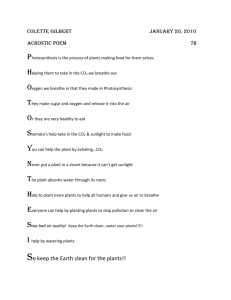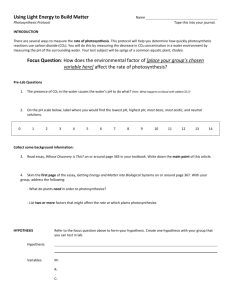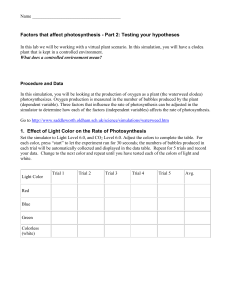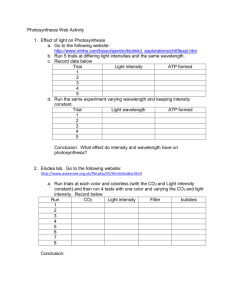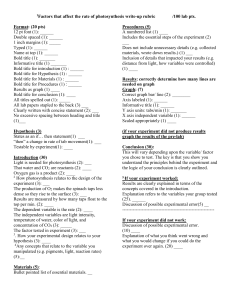photosynthesis axes
advertisement
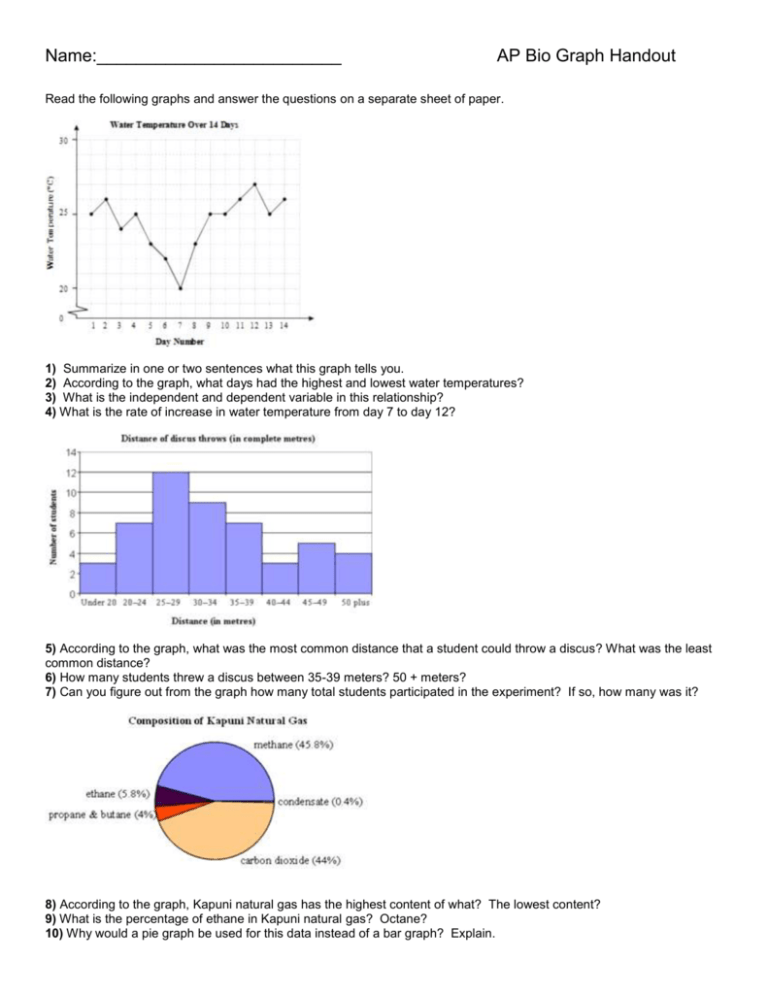
Name:_________________________ AP Bio Graph Handout Read the following graphs and answer the questions on a separate sheet of paper. 1) Summarize in one or two sentences what this graph tells you. 2) According to the graph, what days had the highest and lowest water temperatures? 3) What is the independent and dependent variable in this relationship? 4) What is the rate of increase in water temperature from day 7 to day 12? 5) According to the graph, what was the most common distance that a student could throw a discus? What was the least common distance? 6) How many students threw a discus between 35-39 meters? 50 + meters? 7) Can you figure out from the graph how many total students participated in the experiment? If so, how many was it? 8) According to the graph, Kapuni natural gas has the highest content of what? The lowest content? 9) What is the percentage of ethane in Kapuni natural gas? Octane? 10) Why would a pie graph be used for this data instead of a bar graph? Explain. Graphing Rules: A) The independent variable (what the experimenter controls) is on the X axis, the dependent variable is on the Y axis. B) Label all axes with appropriate units. C) Make sure the numbers on the axes are evenly spaced. D) Make sure the numbers on each axis take up over ½ of the length of the graph paper. E) Connect the dots using a straight edge. The edge of a pencil or your driver’s license will work. F) Make sure that there is a title to your graph. The title can always be “Y axis vs. X axis” if you are in doubt. Draw graphs for the following data on separate graph sheets, and then answer the questions also on the separate sheet. Graph 1: Days Peas have germinated: Oxygen consumed (ml) 0 0 1 3 3 8 6 40 11 75 18 109 25 132 35 140 50 151 60 158 5’11” 212 3’8” 85 5’9” 165 11) Use a sentence or two to summarize what you see in the graph. 12) During what growth interval did pea plants germinate the most? 13) Figure out the rate of oxygen consumed over the course of the entire experiment. Graph 2: Height of person: Weight of person: 5’6” 148 6’2” 190 4’5” 105 5’9” 174 7’2” 270 6’0” 188 5’3” 124 6’4” 231 14) From looking at your graph, what would you expect a human to weigh who is 5’ tall? 6’6”? 15) What type of relationship is there between height and weight? Graph 3: Activity Saturday at noon: Number of Students: Test taking 17 Sleeping 24 Reading 15 Writing 9 Watching TV 86 Activity Saturday at noon: Number of Students: Exercising 18 Cleaning 4 Working 23 Showering 11 Other 15 16) From the graph, which activity was done the most at noon? Which activity was done the least? 17) What activity was most prevalent at 5 p.m.? 18) What is the maximum number of students that could have been shopping at noon? Graph 4: Plant A CO2 concentration of air (ppm): Rate of photosynthesis (ml per min): 0 0 100 5 200 10 300 30 400 50 500 70 700 90 900 100 1100 110 Plant B CO2 concentration of air (ppm): Rate of photosynthesis (ml per min): 0 0 100 20 200 30 300 40 400 45 500 48 700 49 900 50 1100 45 19) Explain what you see in the graph in one or two sentences. 20) Which plant has the highest rate of photosynthesis at low CO2 concentrations? 21) Which plant achieves the highest photosynthesis rate overall? 22) Which plant do you think would dominate in an area that had a CO2 concentration of 400ppm? 23) True or False: For both plants, the higher the CO2 concentration the higher the rate of photosynthesis, Explain your answer.
